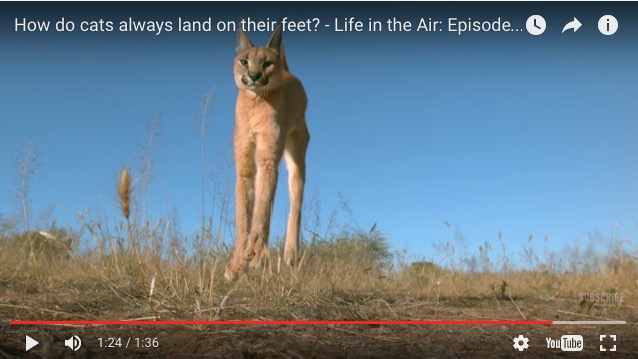Why Do Cats Survive Big Falls? Slow-Mo Reveals the Physics Behind Their “Super Landing”!
I’m Ken Kuwako, Science Trainer. Every day is an experiment.
How can cats leap from such incredible heights and land so gracefully? It’s almost as if gravity doesn’t affect them. The BBC in the UK investigated this secret using a super slow-motion camera. What they revealed was a surprising “physics” that is completely different from the “normal” jumps we usually see.
Be sure to check out this video. It clearly shows how a cat masters the art of landing.



Pretty amazing, right? I learned about this topic from a Lifehacker article titled: [The Reason Why Cats Always Land on Their Feet, Even When Falling from High Places].
Watching the video, you can see how skillfully a cat uses its body to “absorb the impact” of the landing. But what exactly does it mean to “absorb impact”?
Today, let’s unpack this feline super-technique together, using the concepts of “Momentum” and “Impulse” from high school physics!
Unlocking the Cat’s ‘Super Landing’ with High School Physics
In physics, the “oomph” or “force of motion” of a moving object is called “Momentum”. It is determined by the simple formula: Mass (Weight) × Velocity (Speed). A cat falling from a great height has a significant amount of “Momentum” right before it hits the ground.
The act of landing means this “Momentum” must be reduced to “Zero”—instantly.
To stop an object (or change its momentum), you need something called “Impulse”. Impulse is calculated as Force × Time.
If we denote the force the cat receives from the ground as F, and the time the cat’s paws are in contact with the ground as t, the following relationship holds true:
mv − Ft = 0
(Initial Momentum) − (Impulse) = (Final Momentum, which is 0 because it stops)
Rearranging this gives us the key equation:
Ft = mv
(Impulse = Initial Momentum)
Here is the most critical point. The amount of “Momentum (mv)” the cat must change for a safe landing is fixed—it’s determined by the height of the fall. The cat can’t change this value. So, what would happen if the cat landed with a sudden “thud!” (meaning the time t is very small)? Since Ft equals a constant amount of momentum, a small t means the force F on the paws would have to be incredibly large. This enormous force is the true nature of “impact,” which could lead to severe injuries like broken bones.
The Cat’s Superb Technique: Buying Time
So, what does the cat do? Let’s look at the slow-motion footage again. The cat approaches the ground with its legs initially extended straight.

The key is that its legs are not bent from the start. The moment its paws touch the ground, it slowly and deeply bends its joints, like an accordion compressing.



This action—”sinking its body slowly after contact”—is a remarkably clever move from a physics perspective.
It’s a technique designed to maximize the time t it takes for the momentum to drop to zero. Recall the equation Ft = (constant momentum). By using its flexible body to make the landing time t longer, the cat successfully reduces the force F its paws receive from the ground (technically called the Normal Force). This, fundamentally, is what “absorbing the impact” really means.
Impulse Control in Everyday Life
In fact, this very same technique is used in things we do every day.
Take, for example, Kendama (the cup-and-ball game). When you catch the ball in the cup, you slightly bend your knees to “give” at the moment of impact, right? That subtle downward motion is also a way to extend the time t until the ball stops, reducing the force F the cup exerts on the ball and preventing it from bouncing away. If you kept your knees locked and tried to catch it with a sudden stop, the ball would just spring back out.
The cat, using its innate flexibility and instinct, masters this “Impulse Control” perfectly. It’s astonishing to realize that a simple cat jump, which we often overlook, is filled with such sophisticated physics!
Inquiries and Requests
Bringing the wonders and fun of science closer to you! We provide easy-to-understand guides on fun science experiments you can do at home, along with tips and tricks. Feel free to browse around! ・The content of our Science Idea Book is now a published book. Learn more here ・About the author and site administrator, Ken Kuwako: Click here ・For various requests (writing, lectures, experiment workshops, TV consultation/appearances, etc.): Contact us here ・Article updates are posted on X!
![]() We stream experiment videos on the Science Idea Channel!
We stream experiment videos on the Science Idea Channel!

